Sílvia Lanceta & Juli G. Pausas
She looks at you all the time, wherever you place yourself, a few feet above you, enigmatic. Her haunting gaze captures all the attention. You contemplate the seduction of her eyes, grey as the sea at sunset, full of life and expectations. You follow the luminous sharpness of her face. Half content smile. Thin lips, saying so many things you don’t understand. You lower your head and find darkness. Shades of black and hints, to the toe of the shoe. It also captures you.
You take three steps back, four, five … and she keeps looking at you from a distance of time and space. And at this magical distance, the canvas, almost two metres long, is still white. In the Clinton Building in Manhattan, where F. Pausas has his studio, the linen canvas separates the model and the painter. Maria Sampere is standing there, dressed in black from head to toe, the feather of her hat dancing to the rhythm of her breathing. F. Pausas begins to paint the female figure in front of him, applying his innate art and the serenity of the technique learned. Add to that the desire to immortalise seduction. The figure is opaque, confused with the background; its line emerges from the vague shadows. The light bursts.
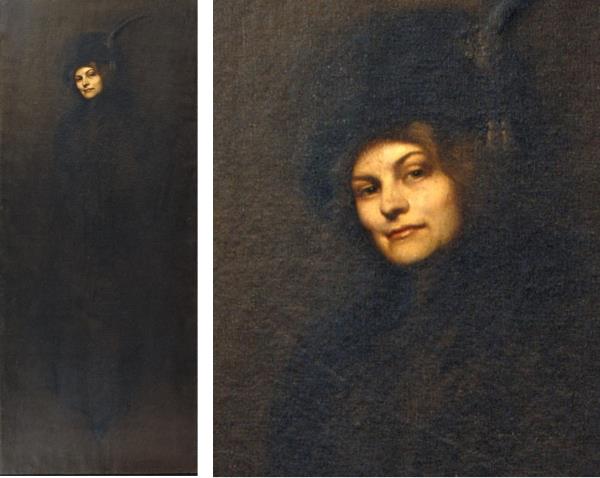
The Americas
Portrait of Mrs. Sampere was presented in society on 11th March 1911, in the Fine Arts Building, where the National Academy of Design inaugurated the 86th annual exhibition. The artistic press commented that the full body portrait of Miss Lampere [SIC] by Francisco Pausas (…) suggests Robert Henri in the audacity of the drawing and in the life and action of the figure (American Art News, New York, 25th March 1911, vol. 9, nº. 24, p. 4).
Since then, the linen canvas, which is no longer white, joined the couple forever.
In 1920, the portrait travelled to Havana. Entitled My wife, exhibited in the former convent of Santa Catalina along with forty-six other paintings by the artist, mostly portraits of the Cuban aristocracy. The success was resounding and the news reached Catalonia. Mr. Pausas is an accomplished portrait artist. All the portraits he paints have an amazing resemblance and extraordinary vigor. In them the psychology of the person portrayed seems to throb. A year later, it was exhibited in the 6th Annual Fine Arts Salon of the same city, entitled Portrait of Mrs. Pauses (Bohemia, Havana, 21st March, 1920, No. 12).
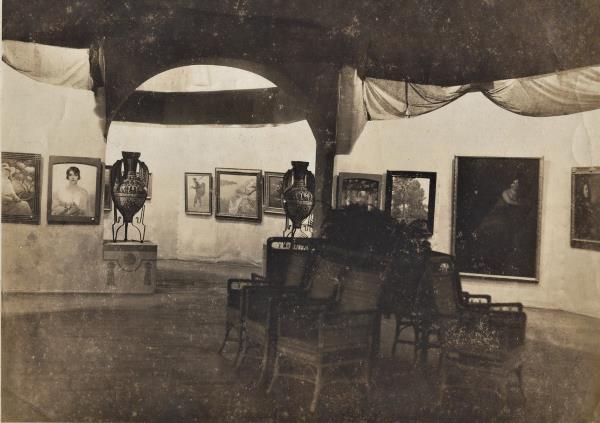
Rolled up with the painting on the outside, so as not to crack the figure, and placed in a cardboard tube, of suitable size, it was embarked on the Juan Sebastián Elcano. Leaving the tropical humidity behind and, just before breaking into the crash of the 29, it arrived in Barcelona.
Arrival in Europe
The presentation of the portrait in society, in the hometown of the painter and model, would take place on 7th February, 1931. Galeries Laietanes hosted the first individual exhibition of F. Pausas in Barcelona. The art critic J.M. Junoy, highlighted, especially, a portrait of a woman with grey eyes and olive wood hair with a very pale and intelligent face (Junoy, JM, L’Actualitat Artística, Llibreria Catalònia, Barcelona, 1931, pp. 73). J.M. del Sucre pointed out that My wife, as the canvas was called then, evoked Carrière’s first good works (Sucre, J.M., L’Opinió, Barcelona, 13th February 1931). And L’Esquella de la Torratxa was of the opinion that Francesc Pausas brings to the canvas the rules and serenity of a Velázquez or a Van-Dyck (Boriel, «Arts and artists», L’Esquella de la Torratxa. Barcelona, 20th February 1931).
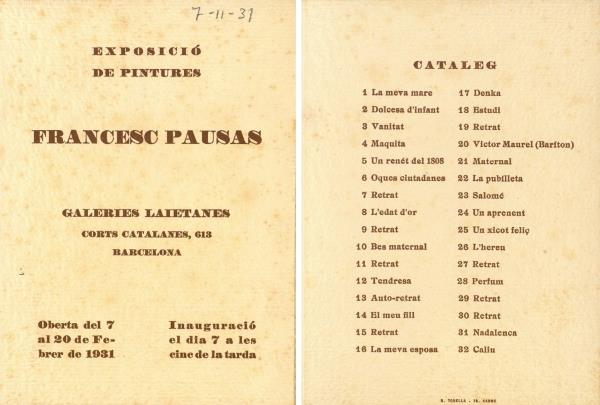
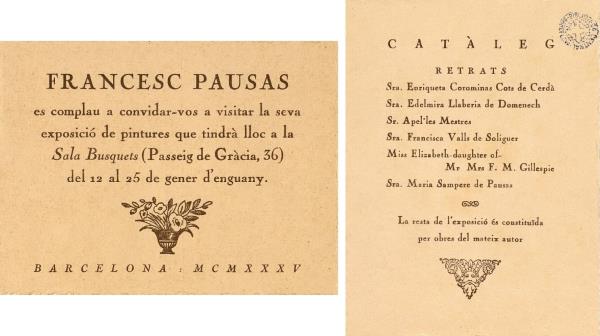
The portrait would stand the uncivil war, trembling every time a bomb exploded over Barcelona; which destroyed part of the building where it survived, raising fears for its integrity. But luckily, in November 1940, Portrait of the painter’s wife was among the works that F. Pausas exhibited, in the Sala Gaspar, and again La Vanguardia paid attention to Some of his paintings, carried out some years ago. , (…) by the artist who paints, recreating himself in doing difficult work. Following classical norms and moving away from modernisms and eccentricities, his painting reaches a serene fullness (Artistic activities. Sala Gaspar 1940-1941. Barcelona, p. 35).
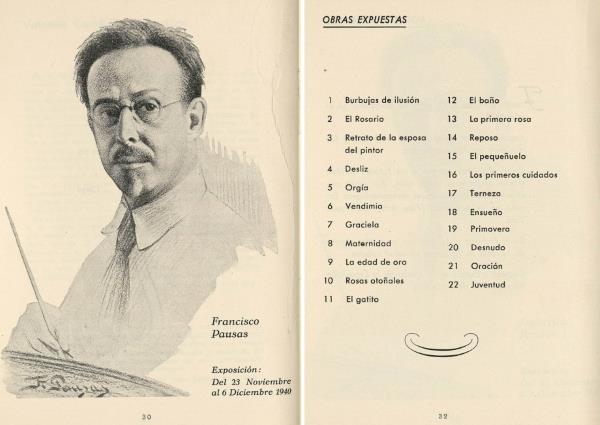
This was the last exhibition in which Portrait of Maria Sampere would enter an art room at the hand of the author. And from the magical distance in which she found herself, Maria Sampere contemplated the portrait, and was not recognised in the disturbing figure that appeared from the darkness with a closed smile and a defiant eyebrow. Now, she traced the sharpness of her face with her gaze and the wrinkles of her face with her fingers. She imitated the posture of the person portrayed, but she was no longer twenty-six years old and did not show off a silhouette full of doubts, but of certainties.
Despite the shortages of the moment and the social context, the oil on canvas of 193.5 x 81.5 cm, was never put on sale. On 9th December, 1946, the board of Amigos de los Museos wrote to the director of the Museum of Modern Art with reference to the original painting by the painter Fco. Pauses, which gives, …, the Lady, Widow of the said artist … dated last June …, we must indicate to you that, having news of your acceptance, and, in attention to the wishes of said Lady, already very old, we ask you to place this picture well in the corresponding place of the Museum.
Portrait of a Woman already belonged to the collection of the Museum of Modern Art, located at that time in the Parc de la Ciutadella. In “Notes of the moment”, on 12th February, 1947, and on the occasion of the presentation in the Saló de Cent of the works of art acquired by Barcelona City Council, Don Valentín Moragas narrated on the airwaves of Radio Barcelona the creation of the portrait in New York, in 1911. The world was living hours of peace and the painter was about to begin a new portrait, that of a small girl with a delicate and smiling face, correct features, mother-of-pearl skin and an intelligent and deep look, which suggested the artist. Until that day Pausas had painted prominent characters… but the one of the new model, treasured a supreme illusion: not for being a compatriot and being the daughter of his friend Sampere, but for feeling a special affection towards the young woman and desire to turn her into his wife. […] The figure of the girl was becoming blurred, confused, blackened, as if sensing the changes to which she would have to undergo over the years; and it is resolved following the teachings that in the Prado Museum, Pausas gained from Velázquez adding, moreover, the pictorial trends that were lacking in New York at that time… The figure was opaque, confused with the blackish tone of the background in which she appears, and her line emerged from vague shadows, but the girl’s gaze, the delicacy of her face, could not be erased over the years and would remain with the expression that would shine through her spirit… and reached our city, like the memory of a love poem of modern times. (…), dreaming of triumphs of a purely artistic nature…”(Moragas Roger, V., «Notes of the moment» from Radio Barcelona, 12th February, 1947. Digital Repository of Documents of the UAB).
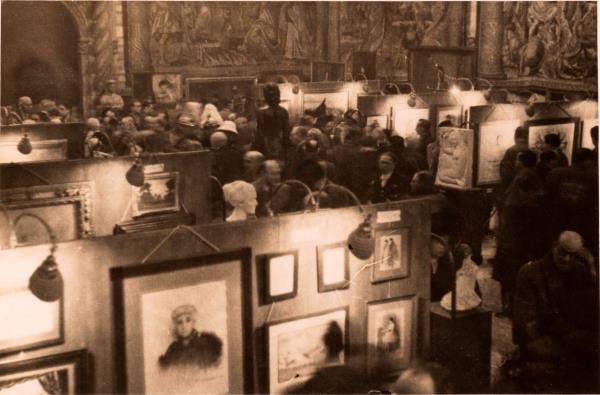
In 1969, the General Directorate of Fine Arts of the Ministry of Education and Science assembled, in the Casón del Buen Retiro in Madrid, an important collection of works of art of Modernism in Spain. Portrait of the artist’s wife was selected to be part of it (Modernism in Spain, Madrid, 1969, catalogue of the exhibition).
And finally at the Museu Nacional
When the Museum of Modern Art was definitively integrated into the National Art Museum of Catalonia, Portrait of a Woman was moved to the facilities of the Palau Nacional, in Montjuïc. With the reopening, in September 2014, of the first floor of the museum dedicated to Modern Art, Portrait of Maria Sampere, wife of the painter was exhibited in the bourgeois portrait room, where it could now be seen from a real distance, and at the same time so magical. Lluïsa Sala described it as one of the last pictorial exponents that can be adjusted chronologically within Modernism. Her conception, however, retains something of the symbolist spirit (…) The expression on her face is sensational due to the detailed outline of the anatomical shapes, the luminosity and a personality that we sense is disturbing due to the effect it produces, but serene by the attitude it conveys. (…). Despite the academicism that usually emanates from the portrait of the painter, sometimes ratified by the influence of official French and English painting of the nineteenth century, the portrait of Maria Sampere is of an unclassical style and probably unique in the production of the artist. Refining the perception a little more, one could guess something of a Whistlerian character and even perhaps the subtle breath of Ramon Casas (Sala i Tubert, L., Modernist painting, directed by F. Fontbona. Enciclopèdia Catalana, Barcelona, 2016 ).
Grateful that this work has overcome the journey to reach the Museu Nacional, you say goodbye to the Catalan Gioconda and leave room 45, thinking that there can be nothing more difficult for the brush to fix the natural gesture of the expression of life or of guessing it in an imperceptible fold.
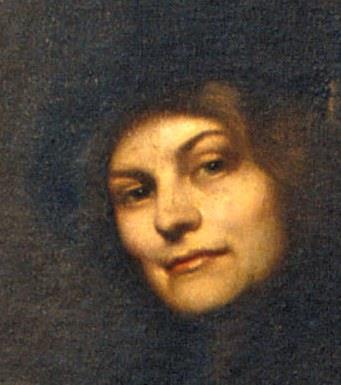
Related links
Francesc Pausas Coll (1877-1944), universal and unknown painter
Maria Sampere and Francesc Pausas in the Museu Nacional d’Art de Catalunya







